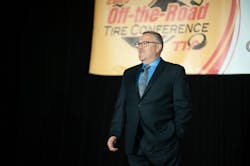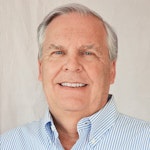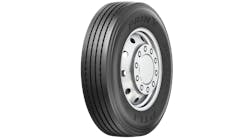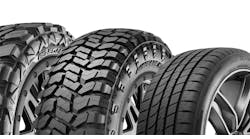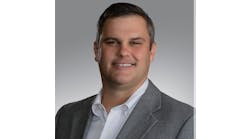Each year during the Tire Industry Association’s (TIA) annual OTR Tire Conference, an industry executive is asked to deliver a keynote address. This year, Shawn Rasey, director of global business development, earthmover, Continental Tire the Americas LLC, looked at a variety of issues that stretched beyond the focus of just the OTR side of our industry.
An industry veteran of over 40 years, Rasey captured not just past changes, but offered a view into the future. When Rasey joined the tire industry, the big five tire makers in the OTR industry (as well as throughout the U.S. in all categories) were Goodyear, Firestone, BFGoodrich, General and Uniroyal.
Rasey also pointed out that the top OTR dealers at the time were the J.W. Brewer Tire Co., Cobra Tire, Brad Ragan Inc., Baum & Adamson Tire Co. and Airdrome Tire Sales.
Rasey then fast forwarded to today and shared his thoughts about “Why what you do matters. Why what you do every day matters. And how the choices you make matter to a lot of people.”
What follows are highlights from his address that covers many issues that extend far beyond the tire industry.
Three OTR megatrends
Understanding megatrends and anticipating change is a key to winning in business, said Rasey. Megatrends are the long-term changes that affect governments, societies, and economies permanently over a period of time. They are not new, simply packaged differently today.
There are currently three megatrends in general manufacturing, says Rasey. The first one is digitalization and miniaturization, the second is big data/analytics and the third is the new workforce. Combining the three leads to disruptive change.
Rasey focused on the new workforce. “The demographics are really changing quickly. It’s reshaping labor markets across the globe, but certainly here in our country. Start with the fact that in today’s rapidly aging workforce, about 10,000 baby boomers are retiring each day. Consider that. Companies will rely more on automation with the millennial workforce that is way more tech savvy. We need to think about how that’s going to integrate into our business.”
Caterpillar Inc., a highly recognized corporation, spends considerable time in looking into the future and trying to make sure they’re prepared with their products to be able to lead in the future. One thing they’re focused on is the exponential technology growth and how to get their arms around it and harness the power of that, said Rasey. Caterpillar pointed out that as they think about their strategies for the future, by the year 2025 the world’s expected population should increase by one billion people (up from an estimated 7.7 billion today). That’s an incredible impact on the way things work and how we interact in that connected world.
10 questions
In preparation for his speech, Rasey asked OTR dealers 10 questions about how they ran their businesses.
Question 1: “When thinking about key priorities in your business life, how important is taking time for strategically thinking about the future?” 94% of dealers said it was either the most important thing or very important, but maybe not the most important. It was pretty unanimous that it was critical.
Question 2: “What part of your business in OTR is price-only driven?” It was a split.
- 37% said 50% or more.
- 20% said less than 50%.
- 20% said less than 30%.
- 13% said less than 20%.
- 10% said less than 10%.
Rasey said there was no right or wrong answer, but a better question may have been how much of your business would you like to be price-only driven? If it’s always just about price with your customers, you’re only ever as good as the last price that was quoted, as long as it was the lowest price.
Question 3: “When thinking about your most profitable customers, what do they value most from you?” The results were pretty unanimous. It’s all about service. Ninety percent said on-time reliable service and 10% said on-site support and service.
Question 4: “When thinking about age demographics in your business, what’s the time frame that represents your biggest risk for continuity of operations?” Again no right or wrong answer, but 20% said this year; 40% said within the next three to five years, and another 40% said five years or longer. Rasey noted it’s happening now. And it’s going to happen in the next one-to-three years, and it’s going to happen in the next three-to-five years. It’s dependent wholly on what’s going on in your business profile.
Technology changes are happening all around us, and they’re going to accelerate going forward.
Rasey looked at the five generations that we’re all working within organizations today: the traditionalists, which are the pre-1945; baby boomers, 1946 to 1965; Gen-Xers, ´96 to ´77; millennials, ´78 to ´95, and the new Generation Z, after 1995. We need to think about these groups, because each segment views work differently, says Rasey. The traditionalists say work is an obligation. Boomers say work is expected. Gen-Xers say it’s a difficult challenge. Millennials say it’s a means to an end. And Gen-Z says it’s going to be constantly evolving.
Secondarily is for us to acknowledge each group’s views on changing jobs. If we think of traditionalists, they’re pretty much going to stay for life. For boomers changing jobs, they’re loyal to their employer but seeking value. For the Gen-Xers, it’s necessary for compensation. For millennials, job changing is expected. And the Gen-Z group is changing jobs constantly.
Question 5: “How significantly do you see tire-connectivity technology impacting your business model within the next five years?” About 94% of respondents said likely or very likely.
Question 6: “How significantly do you believe your customers’ business models will change that will require tires and equipment and operations to be linked in the future?” 53% said a lot, or extensively. Rasey observed that the younger the respondent, the more they saw technology jumping in.
Question 7: “How confident are you that you’ll be adequately prepared to anticipate that change fast enough to sustain your business success over the next three-to-five years?” 63% said extremely or very confident, but there was a bit of a mix. This still leaves 37% who were either just somewhat confident or not so confident. Rasey says the real question is what if we don’t know that there’s a problem? He cautioned that dealers need to guard against complacency and arrogance.
Question 8: “How important will planning for risk mitigation be in your business over the next few years?” Again a very high percent (77%) of dealers really understood that’s the key. “Opinions vary, certainly. Ray Kroc from McDonald’s said if you’re not a risk taker you should get the hell out of business. Gary Cohn, who is an economist and was a senior advisor to President Trump at the beginning of his administration, said if you don’t invest in risk management, it doesn’t matter what business you’re in; it’s a risky business,” said Rasey.
Question 9: “How much does the federal/state regulatory environment affect your future business plans?” 54% of respondents said a great deal or a lot, but Rasey said it was quite dependent on where the dealer was located. If a dealer was in West Virginia or California, there were a lot of high hits. If they were in Iowa or Tennessee, not so much. But one thing is for sure, said Rasey, when the political environment affects us, swings in political power generally impact the regulatory environment as well, for better or for worse.
Question 10: “How important will the ability to differentiate your service offering be from competition in your long-term success?” Virtually 100% of respondents said it’s all about service. Service is going to define success. Service differentiation is going to ultimately define who succeeds in the market. And differentiation ultimately only matters if the customer really values it. Why do it if it doesn’t move the needle?
Rasey concluded his remarks with the following takeaways:
- What you do every day matters.
- It’s important to many people.
- Megatrends are real, and they’re happening now.
- You control your own future, so don’t relinquish that control to the universe.
- Technology changes are happening all around us, and they’re going to accelerate going forward.
- Adapt and overcome.
- Modify your strategies as the market dictates and when it matters the most.
- People changes are in your business now or they will be soon, so prepare for a new workforce.
- Manage the risks judiciously, be smart and calibrate your risk threshold to your own comfort level.
- Service differentiation is going to be the key to your future, and make sure that it matters to your customers. ■
